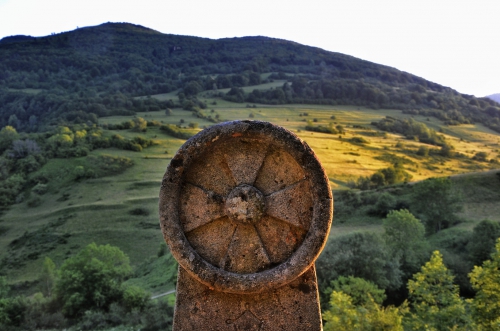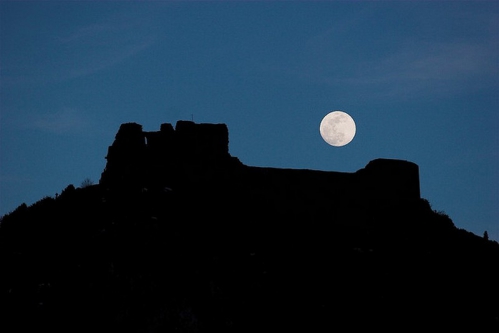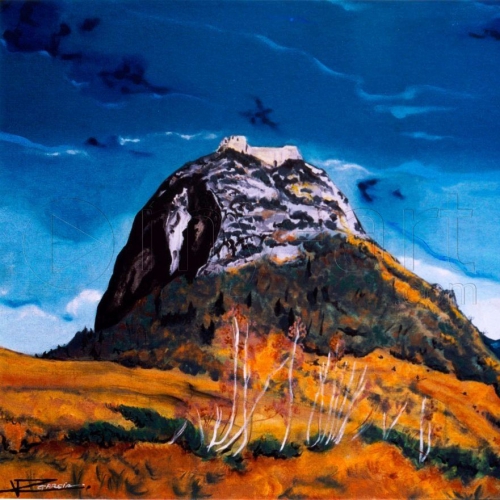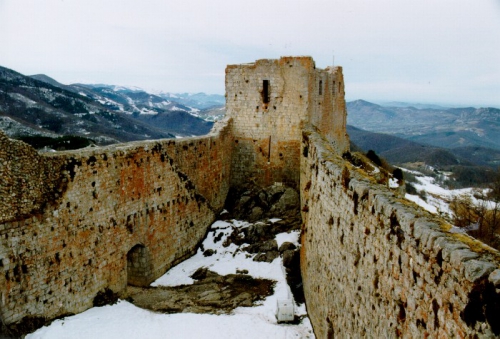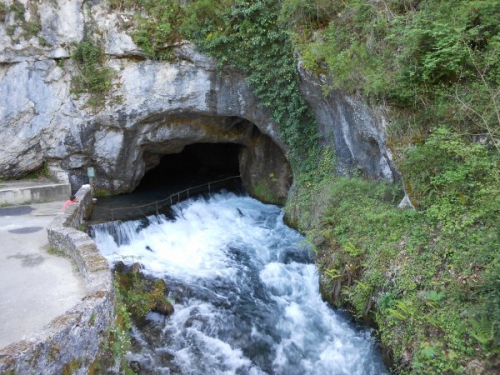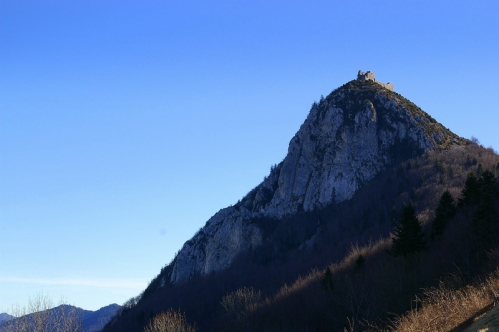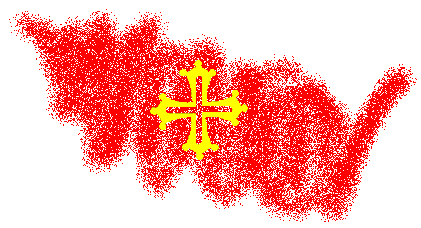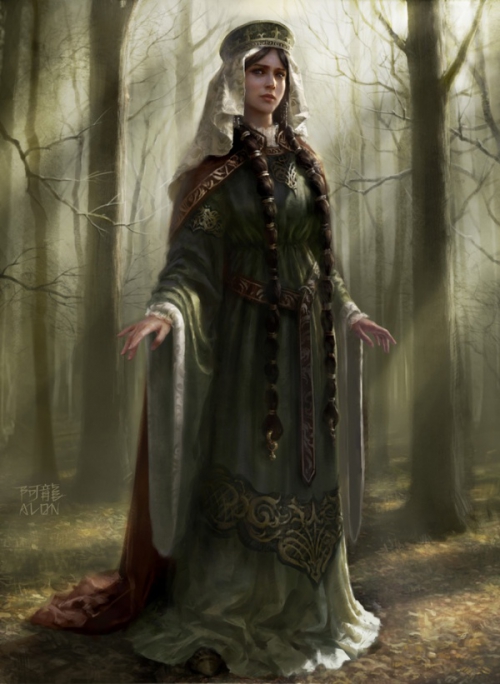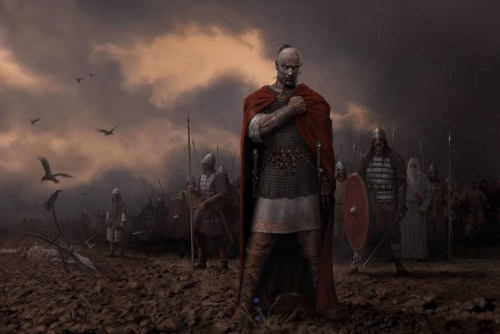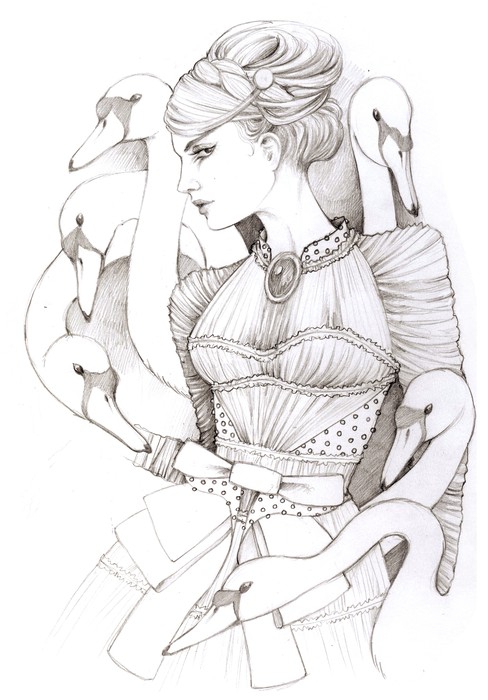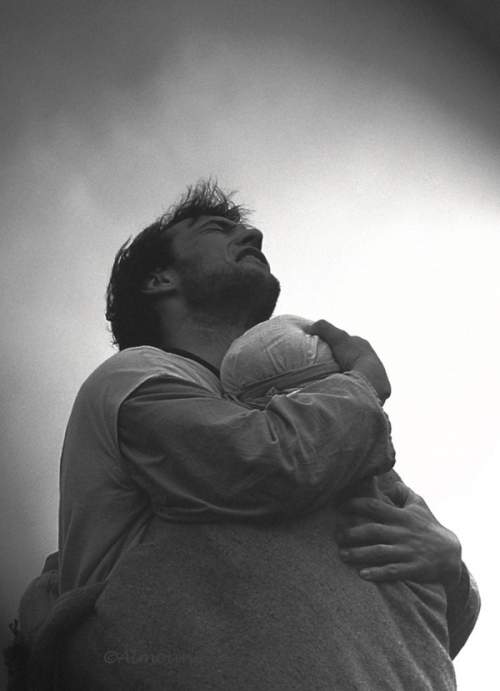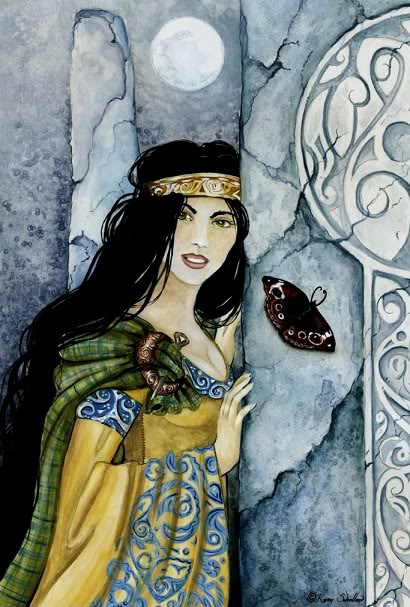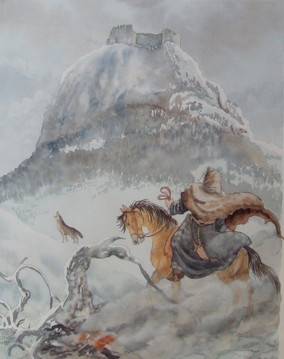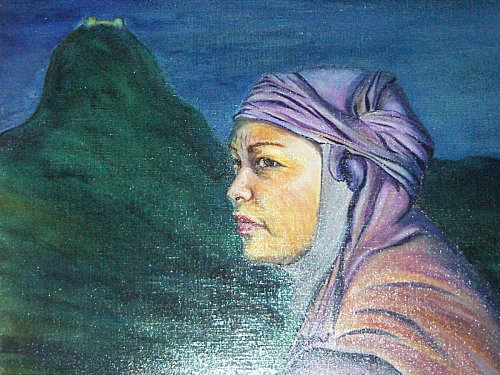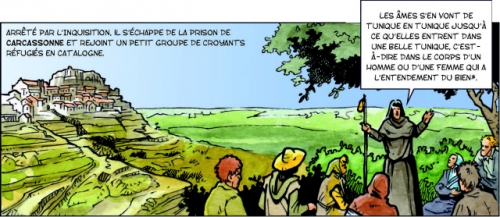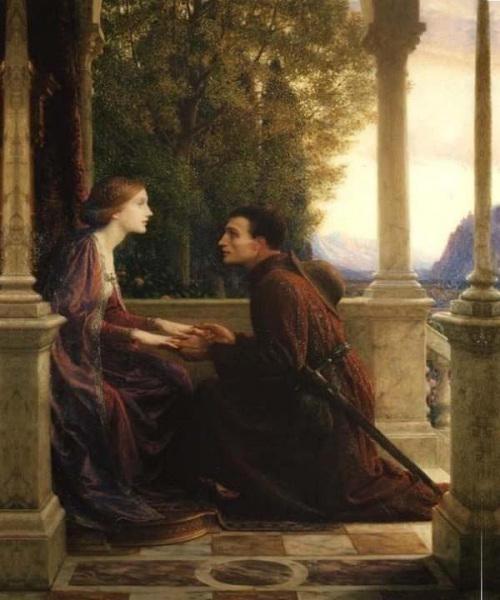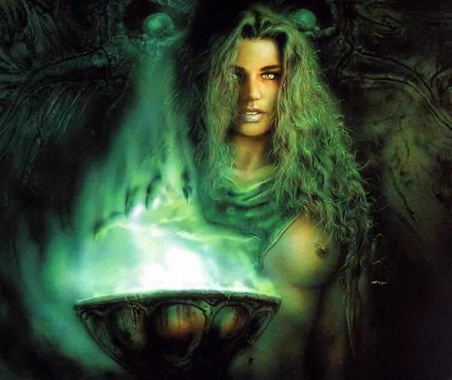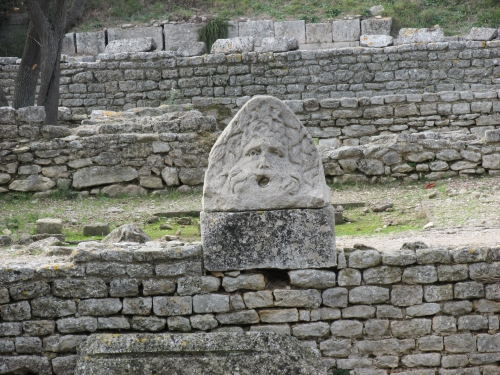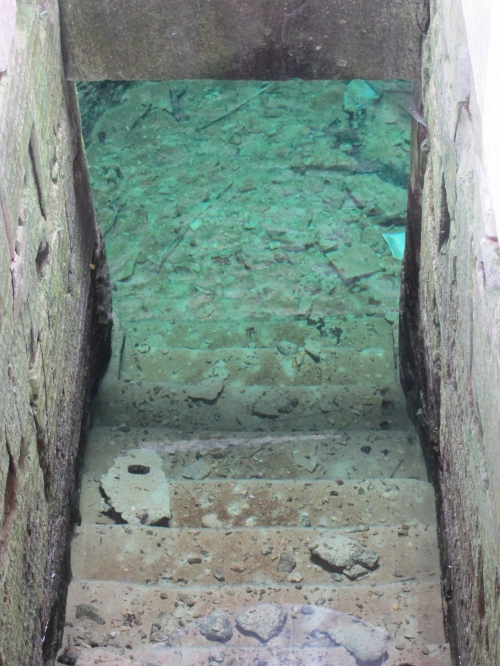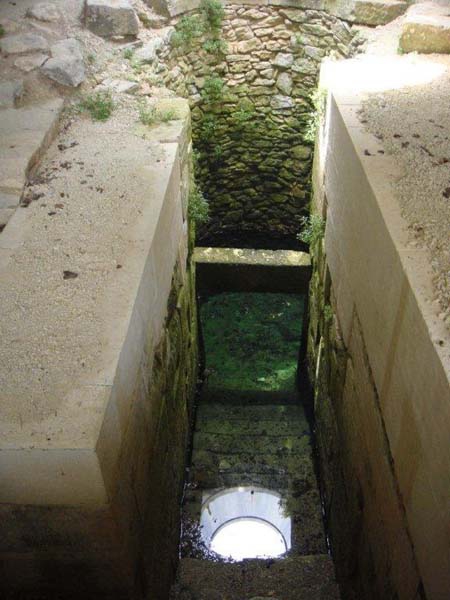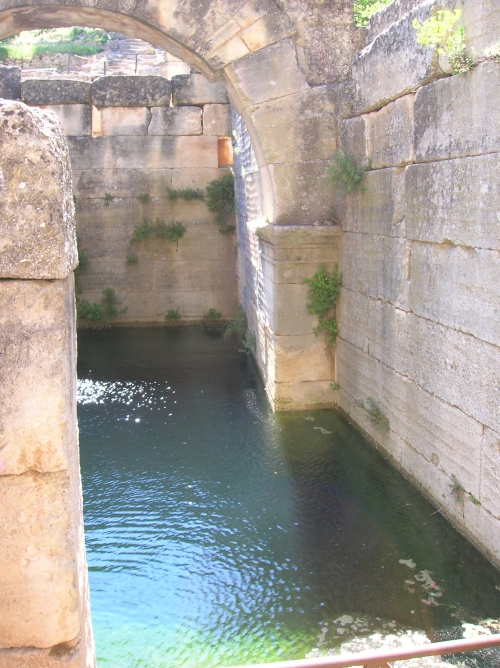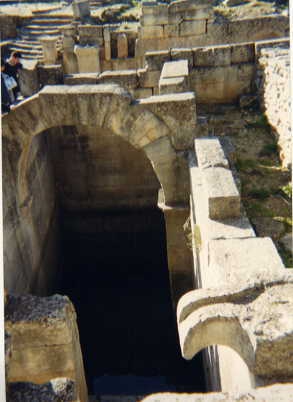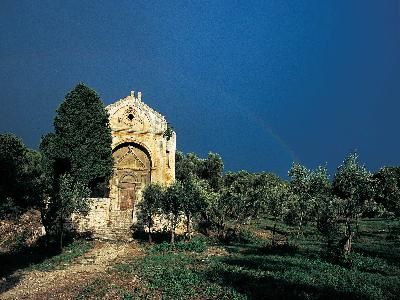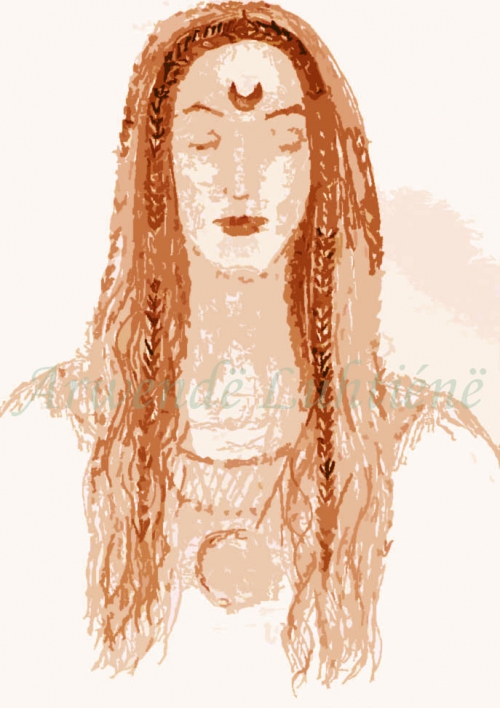Histoire- Recherche
Les celtes à Montségur ?
Les premiers habitants de l’Ariège sont les Ligures réputés pour être un peuple de montagnards et de grimpeurs qui vénèrent les hauts sommets et qui leur avaient tous dédié un Dieu
Puis les Ibères envahissent le sud de la Gaule en 475 av JC
En 400 av JC, des celtes de civilisations Hallstattiennes franchissent le col d’Ibaneta
Vers 300 av JC la tribu des Volsques Tectosages submerge le Languedoc
L’abondance des noms à consonance celtique dans le département de l’Ariège prouve que les gaulois occupèrent le pays de Montségur. Des noms comme Soula, Lucau, Vernajouls, Dun, Brenne, Castelverdun. De même on notera dans le Sabarthes quantité de noms de lieux terminés par AC ou AT
Il y eut certainement un « coin celtique » enfoncé dans les régions pyrénéennes pourtant fortement ibérisées. L’axe de cette pénétration serait le cours de l’Ariège. Le pays de Montségur ainsi que le pays d’Olmes et celui de Foix devinrent et demeurèrent des terres semi gauloises jusqu’à la conquête romaine. La tribu dominante aurait été celle des Tolosates elle-même subdivision de la puissante confédération des Volsques .
Nous trouverons aussi les tribus suivantes présentes et attestées :
-
Umbracinis, tribu cité par Pline
-
Santons
-
Pétrocores
-
Bituriges
-
Consoranis mentionnés par Pline
-
Tarusconines situé sur le Castrum Tarrasco (Tarascon sur Ariège)
-
Kercorates
-
Bébryces (celto- ligures)
-
Sotiates (celtibères) sur le cours moyen de l’Ariège
A l’époque de la conquête romaine, les gaulois sont dans la Narbonnaise et les Ibères dans l’Aquitaine ; toutefois bien avant cela la présence des Ligures est indéniable ; ainsi nous parlerons de populations et cultures mixtes celto-ligues, celtibères ou encore Ibéro-Ligures
Le mot Segur a deux significations possibles
1 ) cela vient du Latin Securus qui donnera segur en occitan et sûr en français
2) proviendrait du gaulois Sego voulant dire force et que l’on retrouve dans l’irlandais Seg c'est-à-dire force, vigueur ; voire encore dans l’allemand Sieg ou victoire. Sego sera repris dans de nombreux lieux celtiques tels que Segodunum la « puissante forteresse » de la tribu des Ruténes en pays Arverne (aujourd’hui Rodez en Aveyron). Aussi Segobriga « la puissante hauteur » situé dans la province de cuenca en Espagne
Segomo était par ailleurs un Dieu gaulois assimilable à Mars attesté par de multiples épitaphes. Segomo est « le victorieux » représenté avec un faucon ou un aigle
Enfin plusieurs noms de peuples comprenaient la racine S G tels les Ségobriges de Massalia, les Segontiacis en Grande Bretagne, les Segoviens des Alpes, les Segusiavis en région lyonnaise, les Seghebia en Italie du nord ou Segobens dans l’Ariège tout prés de Chalablre
Sur l’éperon rocheux de la fontaine intermittente de Fontestorbes à six kilomètres à l’est de Montségur ; se trouve l'oppidum du Mayne. Cet oppidum fut pendant deux siècles une cité celtibérienne . Vous pourrez voir à cet endroit les ruines des murs qui encerclaient un village de la Tène (200 à 100 av. J.-C.). Les fouilles effectuées permirent de découvrir une grande quantité d'objets en fer tel qu’ornements de courroies, de fourreaux, de bagues, de bracelets et de fibules en bronze. Le peuple qui habita ici commerçait avec des contrées lointaines. On a découvert, sur le site, des pièces de monnaie ibères des Ilergétes de Lérida, des Volques Tectosages de Toulouse, de Narbonne, de Marseille et des Celtes d'Armorique. L'oppidum fut déserté après la conquête romaine. Aucun vestige postérieur à la conquête romaine ne fut trouvé sur le site.
Racines d’OC au pays de l’Oie
OC
Deux lettres qui sont déjà tout un symbole puisqu’elles associent le soleil O à la lune C ; avec le symbole de la triple Déesse qui s’en approche étrangement )O(
Mais revenons en arrière et déroulons le fil d’Ariane
En 370 : vient au monde Alaric né d’Ulfira la blonde Goth et d’un prince dont le royaume est situé par delà les Balkans ; ceci après que les Goths furent chassés de Roumanie par les Huns
En 410 ce « Roi de tous » prend Rome et emporte une grande quantité d’or dont un énorme chandelier volé par Tutus dans le temple de Salomon lors de sa destruction en 70 ; puis meurtri par un chagrin d’amour Alaric s’éteint à 40 ans
Athaulf successeur d’Alaric s’installe avec ses Goths dans le Sud ouest de la Gaule où ils vivront deux siècles.
Athaulf assassiné en 418, Wallia son successeur fait reconnaître un état barbare sur le sol de l’Empire romain. Un royaume à cheval sur l’Espagne et l’Aquitaine avec comme capitale Toulouse jusqu’en 511 puis Tolède jusqu’en 711. Ainsi naquit le comté de Toulouse tandis que Saint Saturnin ( Saint Sernin) devient la capitale de l’Arianisme.
Les Wisigoths ou Goths Savants laissèrent beaucoup de légendes transmises en argot, la langue du secret (son contraire est le ragot)
D’aucuns pensent que la richesse de Toulouse vient de son nom « Tholus » son fondateur ou de « Thula » qui en sanscrit signifie « Balance » et la balance céleste c’est la Grande ourse
Mais c’est un autre animal que Toulouse adoptera comme symbole : l’oie qui lui sera ce que le coq est à la France
Souvenons nous que le tout premier livre de conte de fée sera Contes de Ma Mère l’Oye. On garde des troupeaux d’oies dans les plaines du Danube et dans la région toulousaine. Les oies ont toujours servi à tirer des présages (le jeu de l’oie ne symbolise t il pas le parcours qui conduit au cœur de l’inconscient où réside l’Esprit ?).
C’est pour cela que les Romains gardaient au Capitole celles consacrées à Junon, qui les sauvèrent en 387 du siège des Gaulois d’un Brennus. Leur rôle de gardiennes était alors établi. Il y avait aussi des oies au Capitole de Toulouse avec les Capitouls.
Ma Mère l’Oye est connue à Toulouse sous le nom de la reine Pédauque, en toulousain « pé d’auca » signifie pied d’oie, c’est-à-dire patte palmée. Cette reine Austris aux pieds palmés « fille de Marcellus 5ème roi de Toulouse » (selon certains textes) mourut de la lèpre et fit construire la première église consacrée à Marie en Gaule, la Daurade décagonale à coupole ouverte au centre, où se trouvait son tombeau. Il a été retrouvé et c’est celui de la reine Ragnachilde, femme du roi Wisigoth Euric.
Voyons là le décalage avec le contexte historique :
Selon Renée Mussot-Goulard, Pédauque est une princesse wisigothe, de la dynastie des Balthes, fille d'Alaric Ier, sœur du roi des Wisigoths Wallia et de la princesse Pélagie (femme du Comte Boniface puis d'Aetius). Elle est l'épouse de Théodoric Ier, roi des Wisigoths et lui donne deux fils Thorismond et Théodoric II, à leur tour rois des Wisigoths. Il faut ainsi reconnaître dans le roi Marcellus des textes anciens, une allusion au dieu Mars qui est une constante des fondements de la royauté Tervinge et que l'on retrouve jusque dans les champs des guerriers. Il s'agirait donc d’une allusion au roi Alaric Ier, identifié à Mars
Sa réputation de reine aux pieds palmés serait une mauvaise interprétation de son nom. Elle était de religion homéenne (une déclinaison de l’arianisme) , donc hérétique pour les catholiques qui conteront son histoire, et le dessin du pied palmé étant un signe distinctif du Moyen Âge pour désigner les exclus ou les marginaux, cette particularité corporelle lui serait ajoutée à tort
Quoi qu’il en soit, le thème de la Reine Pédauque réunit plusieurs constantes : il s'agit d'une femme d'origine noble ou aristocratique, atteinte soit par la lèpre, soit ayant un pied palmé comme celui d'une oie, et souvent liée au thème de l'eau (les bains et l'aqueduc, les diverses fontaines et sources miraculeuses). Or TOLo veut eau en celtique (surtout de source).
L’oie représente souvent l’esprit féminin dans la mythologie, elle est associée à Minerve, à Aphrodite, et à Belisama chez les gaulois voire à la déesse-mère celte Brighid
La patte d’oie signe l’état de menstruation. Or, le tabou universel des règles établit qu’aucun homme ne doit voir une femme dans cet état. La fille poursuivie et sur le point d’être violée, montre sa patte d’oie. Le violeur présumé est effrayé et s’enfuit.
Le statut des menstrues, que certaines femmes appellent quelquefois “les ourses”, est de générer les cycles du temps. Elles sont un symbole de pérennité et donc une espérance d’éternité. La racine “men” a le sens de “mesure”... du temps. (d’où “mensuration”). On ne peut y échapper.
La patte d’oie se réfère donc au réel sacré qui nous échappe et nous effraye. Le pouvoir de la (re)génération est intimement lié au cycle menstruel et fait l’objet, en même temps, de toutes les envies et de tous les effrois des humains. L’effroi surgit d’ailleurs souvent devant une quelconque difformité corporelle : boiteux, bègues, borgnes, bossus, roux, ont toujours un caractère “animal” et donc divin. On leur prête des savoirs mystérieux. Il faut s’en méfier. La menstruée participe du sacré par le fait de son impureté qui elle aussi participe intimement du sacré.
L’oie sera aussi le symbole des pèlerins faisant le chemin de Saint Jacques de Compostelle associé à la coquille Saint Jacques soit un symbole on ne peut plus féminin
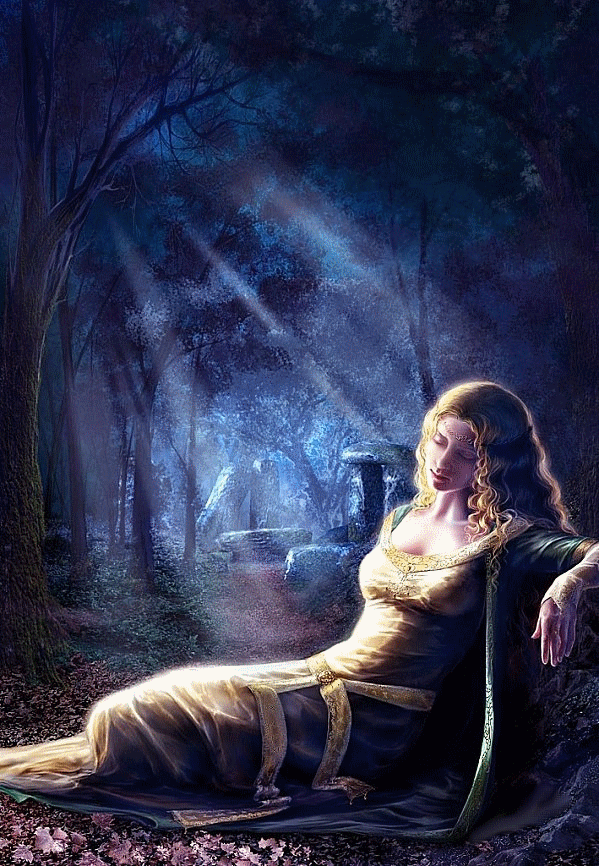
Ainsi en déroulant la pelote d’Ariane nous revenons à la femme.
C’est elle qui en Occitanie au-delà de la clémence du climat, de la richesse de la terre aura permit l’implantation inattendu du catharisme en terre d’OC. En effet le catharisme leur proposera une occasion de se réaliser. D’abord parce que, et c’est remarquable pour l’époque, elles sont traitées en égales des hommes. Elles ne sont plus seulement des ventres pour procréer mais une place dans la société.
La femme comme le Parfait a une place entière dans la société occitane en émergence. Elle est égale à l’homme au sens de la complémentarité car une Parfaite n’est pas moins aimé et respectée que son homologue masculin. Elle suit les mêmes enseignements et reçoit les mêmes initiations pour parvenir au statut de Bonne-femme.
La Parfaite donc pouvait vivre par elle-même dans la dignité, reconnues, aimées et respectées. Il lui était ainsi possible de garder toute sa féminité, mais elle avait autre chose à prouver. Pas seulement d’être l’objet de plaisir des hommes ou de pouvoir mettre un enfant au monde mais aussi d’enfanter d’une idée, d’un courage, d’une lutte.
Phénomène Cathare
Phénomène Cathare
« Va mon enfant, dans la forêt où tu n’entendras plus vibrer la parole humaine. Instruits toi avec le hurlement des loups, le craquement des branches, le bruit des eaux sur les galets. Car la parole vivante naît du silence de l’homme. Ceux qui comme toi sont marqués pour perpétuer la vérité à l’aide des mots qui s’envolent, doivent préparer dans la solitude la naissance du verbe » Maurice MAGRE (Le sang de Toulouse)
On n’étouffe pas la vérité sous le poids des persécutions entreprises au nom de vérités particulières liées aux intérêts matériels
Si on peut supprimer le porteur de vérité on ne peut s’affranchir de celle-ci
Des rites archaïques ; une spiritualité nouvelle
Deux ouvrages : Le livre des deux principes, la cène secrète
Le réel est le fruit des deux éléments ennemis
Dans les revêtus, les Parfaits, on vénérait ceux qui avaient déjà rencontré leur Esprit et qui formaient un Ordre d’initiés dont les règles de vie ascétiques étaient évidemment sévères mais ne s’imposaient nullement aux fidèles (les croyants). Ceux-ci avaient l’assurance de disposer de vies successives pendant lesquelles la purification et le perfectionnement restaient possibles. Et cette notion d’un développement intérieur graduel effectué au prix d’un effort personnel devenait le fondement efficace d’une conduite morale et sociale plus humaine et plus pure. Il n’était pas besoin de faire hâtivement son salut au cours de la vie présente, en se retirant dans des couvents isolés du monde pour y « châtier la chair » ; il fallait au contraire enrichir ses expériences en participant à la vie quotidienne, travailler pour gagner sa vie, instruire les autres, les secourir, les aider, supporter avec tolérance et une patience bienveillante leurs imperfections ; toutes vertus humaines qui leur ont valu le surnom de Bonshommes
Les derniers Cathares n’avaient pas d’édifices spécialement destiné au culte, dans le Languedoc. Ils accomplissaient leurs rites et faisaient leurs prédications dans n’importe quel endroit, surtout dans les maisons des croyants qui leur donnaient asile et où se réunissaient les fidèles. Ils blâmaient l’Eglise romaine qui construit, pour y célébrer sa liturgie, des monuments splendides et couteux. Elle a beau les consacrer, ils ne méritent pas plus de respect que les bâtisses ordinaires. La véritable église, dit Bélibaste, est le cœur de l’homme, temple de l’Esprit saint ; et la maison de la prière est tout endroit où l’on peut se recueillir
Deux entrées :
-
Hérésie
-
Civilisation originale
Si l’hérésie s’est développée avec succès dans différents pays d’Europe mais le catharisme en tant qu’expression spirituelle d’une civilisation spécifique avec sa culture, ses mœurs, ses lois s’est épanouie dans l’Occitanie du XIIème siècle.
« Dans le Midi de la France, la doctrine et le mode de vie cathares, ont traduit l’âme, la sensibilité profonde de tout un peuple. Ce fut le produit spontané, naturel, d’une certaine manière de voir et se ressentir le monde, propre à cette société occitane de ce qu’on pouvait appeler la société française et qui ne concernait que le nord du pays » René NELLY
Nul n’est censé ignorer la Loi-re
Le catharisme n’est pas une déviation ou un branche hérétique du christianisme comme le sera plus tard le protestantisme ; il procède d’une conception du monde, d’une démarche spirituelle et intellectuelle complètement opposée à celle du christianisme traditionnel
Pour qu’une religion originale se soit ainsi formée, il fallait qu’il y ait un terrain social favorable, une civilisation originale.
Les cathares prêchaient dans les châteaux cherchant la conversion des nobles et non du peuple
Les seigneurs occitans voyaient dans le catharisme un moyen de s’affranchir de la tyrannie de Rome
Leurs femmes semblaient dans l’ensemble plus attachées à l’hérésie, parce qu’elles sentaient confusément que celle-ci tendait à donner plus de liberté et de dignité à tout leur genre
Toutes les sociétés inégalitaires ont été hostiles à l’émancipation de la femme
Le catharisme peut être considéré comme une gnose puisqu’il prétend libérer les âmes par une connaissance totale (celle du Bien et du Mal) ; et puis le catharisme a développé un contenu ésotérique, face au formules traditionnelles du christianisme (commentaires du Pater)
Il y a d’incontestables similitudes entre la doctrine proposée par Mani quand à la création du Mal et le point de vue cathare mais cette rencontre idéologique ne suffit pas à prouver que le catharisme procède directement du manichéisme
Bonhommes et Troubadours ont vécu cote à cote pendant plus de deux siècles dans les mêmes régions occitanes notamment les comtés de Toulouse et de Foix et le vicomté de Carcassonne
Leurs intérêts se confondaient souvent car ayant les mêmes protecteurs. Leurs conceptions ou idéologies bien que très opposées dans le fond présentent cependant des points de convergences (notamment concernant le lien du mariage)
L’intention des troubadours était de purifier l’amour de tout ce qu’il n’était pas par nature et non pas comme les platoniciens de le détacher complètement de la sexualité
Les troubadours tenaient l’amour conjugal comme vénal utilitaire et situaient souvent le véritable amour hors des liens du mariage. Ils croyaient sans nul doute que toute union fondés sur l’intérêt et la soumission forcée de la femme au mari ne pouvait s’accorder avec leur vision de l’amour cordial
-
Cordial : « qui vient du cœur, qui est particulièrement sincère ; qui vient du plus profond de soi-même »
Les Bonhommes revêtus qui rejetaient le mariage et le « commerce charnel » pour eux même le toléraient chez les croyants. Toutefois ils le discréditaient ainsi que les troubadours mais pour d’autres raisons.
Deux visions subversives qui s’accordent par circonstances et non dogmatisme mais un même phénomène social pour deux doctrines « le fin amor » et le catharisme tendaient à libérer la femme en neutralisant la notion de péché charnel
-
L’amour n’est pas péché mais vertu disent les troubadours
-
Il est toujours péché disent les Bonhommes mais pas pour les simples croyants
Ainsi libertinage d’un coté et abstinence ascétique de l’autre deviennent deux outils d’émancipation de la femme
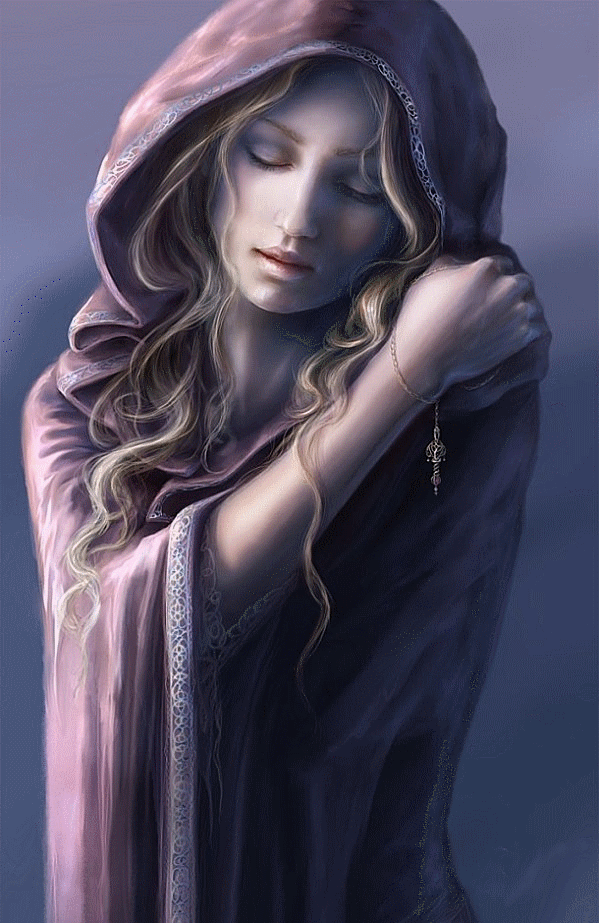
Les Bonhommes professaient qu’il n’y a pas de scission entre l’Esprit (AWEN) , le monde spirituel divin et le monde humain. L’homme possède outre son corps et son âme, un esprit, c'est-à-dire un élément provenant de ce mode divin, fondement même de son individualité, de son développement personnel, de son éternité. Placé dans un monde terrestre déchu, il pouvait « faire son salut » par ses propres moyens et, en premier lieu, par une connaissance de ce monde divin et une purification de ses attaches matérielles, qui lui rendaient possible le contact avec le monde divin ; celui-ci s’établissant par l’intermédiaire du « Maître intérieur » qui n’est autre que son Moi éternel dont le moi temporel n’est qu’un reflet adapté à la vie terrestre
Les manichéens disaient déjà que l’Homme universel était descendu en ce monde pour contribuer à son évolution, de sorte que cette descente nécessaire n’était pas un péché originel tel qu’il est décrit par le mythe connu. Il s’agit dès lors pour l’homme, comme le montre dans la spiritualité moderne, de collaborer à cette évolution du monde grâce aux forces qui surgissent des profondeurs de son âme. …On ne pénètre à l’intérieur des êtres que par l’amour et c’est ainsi seulement qu’on peut avoir accès au domaine des forces vivantes et les voir, s’élever au niveau des âmes et les entendre, parvenir à l’intuition des individualités humaines. C'est-à-dire qu’en nous dégageant des choses extérieures, en nous purifiant nous retrouverons la voie de la communion avec la Tout et l’Un. Faisons le dans la conviction profonde que seul un amour spirituel nous donnera peu à peu une vraie connaissance de nous même et du monde
Paganism in Provence:
How the Mother-Goddess Became the Mother of God
by Vincent Bridges © 2004
Journal of the Western Mystery Tradition No.6. Vol. 1, Vernal Equinox 2004
<One>
The true dark ages of Europe are not the centuries after the fall of Rome, but the millennia before its appearance as a belligerent republic on the Italian peninsula. The megalithic Beaker People, who constructed major standing stone temples and other geomantic structures along the northwest coast of Europe at roughly the same time period as the rise of Egypt’s Old Kingdom, left us little but the mute relics of archaeology. More survives from the Celts, at least in the way of an oral tradition, but the subsequent displacement of their culture by the Romans left us only a distorted view of their spiritual beliefs.[1]
Even more shrouded in darkness are the cultures, such as the Etruscans, which formed part of what was called Liguria by the Romans. This was a somewhat broad region, from northern Italy along the Mediterranean coast to the Pyrenées, composed of many non-Celtic tribes and federations with a similar language and religious practices. From the archaeological and linguistic evidence, the Ligurians appear to be descendents of a central European Neolithic culture, not directly connected to the Beaker People and the megalithic culture. They also attained a rather high degree of cultural sophistication.[2]
In a linguistic sense, what we now call civilization spread across the Mediterranean from east to west. The Neolithic cultures, for all their complex astronomy and megalithic constructions, were pre-literate and this caused their long slow decline and disappearance. A variant of a hieroglyphic or ideographic depiction of language developed in the far west of Europe, as it did the Middle East and in the northern valleys of China, but by the 5th millennium BCE, it had disappeared.[3] This lack of a written language was the primary reason for the darkness. In the pictoglyphs of the Camonica valley of northern Italy and Switzerland, we see the recapitulation of such a linguistic process, but many thousands of years after, and therefore behind, the progress of other cultures to the east.[4]
Semitic civilisation arrived with the Phoenicians in the middle of the second millennium BCE and forced the Neolithic Ligurians into the Bronze Age. Along with the trade goods and bronze weapons came a new idea, an alphabetic script in which language could be transliterated. The Etruscans adopted the idea for their now virtually indecipherable language, as did the ancestors of the Romans and cultures as far a field as the isolated Neolithic farmers on Malta. A written language allowed for vast advances in culture, and the civilizations in the western Mediterranean started on a long growth spurt that would reach its climax with the triumph of Rome in the Third Punic War.[5]
It is of course to Rome that we are indebted for the very word and concept of pagan. To the civic-minded Romans of the early republic, slaughtering its way to power on the peninsula, a pagan was literally a “country bumpkin” or rural person as opposed to one who lived in a city. Their worship was not that of the civic priesthood, a fairly orderly affair of tutelary deities and propitiation of natural forces, but that of "the Old Time Religion," the ancient pre-literate nature worship surviving as a folk, and therefore distinctly rural, tradition with both ecstatic and shamanic elements.
This pagan tradition would have a long history; perhaps because of its pre-literate, non-linguistic origin it survived from the dark ages of the pre-Roman world on through both Empire and Christianity, only succumbing at last to urbanization and industrialization in the 19th and 20th centuries. Charles Leland, in his Aradia[6], stumbled on traces of its survival as Tuscan witchcraft in the 1890s and as early as 1566 the ideographs of the Neolithic Camonians were featured in the Arbatel of Magick where they were called the Olympic spirits.[7] The ancient mythic structure, and its shamanic techniques, survived because it connected directly to the land and to nature, making it in the truest sense, pagan or of the countryside.
The strega of Leland's Aradia and the sigils of the Arbatel represent a minority and distinctly non-mainstream thread of the ancient tradition’s survival. They survived by hiding and becoming occult. In other places, the tradition survived by absorbing other influences and adapting them into a truly popular culture. At times, this method brought whole populations into conflict with the authorities, such as the Church of Rome, and the pressure of time and politics produced a superficial uniformity that allowed for the tradition’s survival only as a folk memory.
But it did survive. And traces of it can still be found, sometimes in the oddest of places.
<Two>
The center of the region the Romans labelled Liguria fell on the delta of the Rhone River in southern France. Just before the Rhone splits into its two main channels, a last straggling arm of the Luberon range, the Alpilles, reaches westward, ending in a jumbled and rocky promontory a few miles from the river. This protective line of hills forms the baseline of a triangle with the upper lines created by the confluence of the Durrance and the Rhone. Within this secure and fertile triangle, successive waves of ancient cultures established their communities and towns.[8]
Neolithic farmers, the Ligurian ancestors, arrived early in the seventh millennium BCE, and dwelt in Arcadian simplicity until Bronze Age trading cultures, such as the Egyptian, Mycenaean, and most significantly the Phoenician arrived in the second millennium. A thousand years later, Celtic tribes began to filter down the river from their European homeland north of Lake Geneva and conquered or integrated with the local cultures. Just as this cultural upheaval was beginning, more than half a millennium before the birth of Christ, Greek traders arrived and built a fortress at the point where the Rhone forks. They called it Theline, but to the Romans it became Arelate (from the Celtic Arlaith), or Arles in French.[9]
As the two communities, Greek and Ligurian, mixed and grew, a new and larger city in the protected delta north of the Alpilles, near the present-day town of Saint-Remy-de-Provence, was founded. Nestled in a narrow valley to the north of its sacred mountain stood the ancient spiritual center of Liguria, the city of Glanon, Romanized as Glanum Livii. Glanum's authority throughout Liguria depended on its closeness with the shamanic priesthood at Les Baux and in the Valley of the Ancients at Cordes. This closeness would continue until Glanum’s eventual abandonment in the 4th century CE, and beyond.[10]
Even as Arelate grew, after 49 BCE, into a smaller version of Rome, Glanum adhered to its old ways, absorbing first the Greeks, then the Romans, and then in the middle of the first century CE, an influx of Jews from Palestine and other parts of the new Roman Empire. Some of these Jews were followers of a rabble-rousing magician, Jesus the Nazorean, who had just claimed the ancient throne of David in Jerusalem, and been executed for treason by the Romans. The fleeing followers included, perhaps, members of Jesus' immediate family. As they spread throughout the region preaching their Gospel, the cultured and thoroughly Hellenized Ligurian philosophers were also converted to the new faith. From this unique blend of spiritual influences would grow an alternative version of what, a century or two later, would be called Christianity.
The accretion of spiritual influences in the region began long before the arrival of Christianity. The Egyptians of the 18th and 19th Dynasties arrived more than a millennium before Glanum was founded at the foot of its holy mountain. The Egyptians built trading forts off what was then mouth of the Rhone, near the present day Ste. Maries-de-le-Mer, and traveled up the Rhone as far as Lyons. The Phoenicians followed, bringing bronze and an alphabet, and in the Greek era, trade flowed freely from Alexandria by way of Massilia (Marseille).[11]
With the trade came a new influx of ideas and philosophies from the east. In the late third century BCE, Buddhist missionaries arrived, dispatched by King Asoka in India to preach the Eight-fold path to all the ends of the earth. For the next three centuries, small enclaves of Buddhist hermits could be found living in the ancient grottoes and caves of the region. Hellenized statues of the Buddha have been unearthed in the caves near Lamanon, and in at least one grotto reportedly used by Mary Magdalene, north of Nimes.[12]
This unique overlapping of influences created the very cosmopolitan and syncretic context from which the new faith, early Christianity, emerged. It appeared suddenly and full blown with the fervour of a Jewish messianic cult, the compassionate techniques of the early Buddhists, and an emphasis on the Mother-Goddess that is pure paganism, recognizable all the way back to the first Neolithic hunters. While Glanum held to its ancient pagan beliefs almost to the very end, it was at Arles that the old Ligurian paganism was most completely transformed into a unique version of the new "Christianity."
When Hannibal crossed the Rhone at Ernaginum, a few miles west of Glanum in 218 BCE, the Gallo-Greek settlement to the south that would become Arles was already a trading post of some note. The earliest versions of the Greek legend of Jason and the Argonauts suggest that they sailed west from Argos, around the heel of Italy and through the Strait of Messina to the mouth of the Rhone; then up the river, founding the trading center of Theline at the head of the Rhone delta on their way to the land of the Golden Fleece. This was located, according to proponents of this theory, around the source of the Rhone at Lake Leman. Traces of this early Greek exploration remain in the local Herakles legends, depicted on the very Christian 12th century CE church of St. Trophime.[13]
Three hundred or so years after its founding, when the Romans arrived in the first flush of their empire building, the Greeks of Theline were cultured philosophers who had dwelt in peace so long they had virtually forgotten the art of war. Rome saved them from the more barbaric tribes of Celts sweeping down from the north, but at the price of their independence. The Salian confederation of Greeks and Ligurians were defeated by the Romans within a generation of their rescue and soon thereafter the entire region was annexed as Rome's first province, the Provincia Narbonesis. A century later, Augustus and Julius Caesar having made safe the roads back to Rome, the first province, Provence, became the center-piece of the transalpine empire.[14]
Under the Romans, Arelate retained its commercial status and flourished. Its rapid rise can attributed to its siding with Julius Caesar against Pompey in 49 BCE, for which it was rewarded amply. By the late first century CE, Arles had also become an ecclesiastical center, a position it would retain for the next millennium, partly on the strength of its legendary cemetery, the Alyscamps, and its association with the early church and its relics. Perhaps the most famous necropolis of the Dark Ages, the Alyscamps (from Elisii Campi, or Elysian Fields), was built outside the city walls, as were all Roman cemeteries, and along the Via Aurelia, the main road to Italy and Rome. By the late first century CE, it was famous as a meeting place for Christian mystics.
In 314 CE, Constantine came to Arles to swear before the Church council, and on the Alyscamps’ relics, that the Christian God was his personal protector. All of this attention made the Alyscamps famous, and it became so desirable as a final resting place that bodies were shipped from all over Europe for burial in its holy grounds. The twelfth-century Chronicle of the Pseudo-Turpin informs us that the peers of Charlemagne, Roland, and the other fallen heroes, were transported with great difficulty to the Alyscamps.[15]
Arles therefore was the focal point for whatever version of "Christianity" swept the region in those early years of the Common Era. We must be careful, as the quotes around Christianity in the last sentence indicate, because while this new spiritual collective would be later seen as distinctly and uniquely Christian, it is not clear that this was so in its origins. As we will see by looking at the survivals of an ancient paganism embedded in the early layers of the new faith, this version of "Christianity" drew heavily on the ancient traditions of Our Lady Underground or the Goddess of the Springs, the Neolithic Mother-Goddess and her successors.
<Three>
The Neolithic Ligurians, from the scanty evidence of the Camonica valley pictoglyphs, seem to have worshipped a mysterious Mother-Goddess of the kind described by anthropologists such as Marija Gambustas.[16] Part of this larger complex of beliefs was the tradition of the Mother-Goddess as the animating spirit of grottoes and sacred wells or springs. Our Lady Underground, a common label given to the Black Madonnas so popular in the 12th and 13th centuries CE, derives from these ancient Mother-Goddess traditions.
The Ligurians of Provence also worshipped a version of Our Lady Underground. This was first Hellenized then Romanized into a local cult of Diana as patroness of the springs, or the nympheum. Remains of these temples can be found in the temple of Diana at Nimes and at the very ancient nympheum of Glanum, but the traditions associated with the worship of Our Lady Underground all but disappeared as she merged during the early Christian era into the Virgin Mary.[17]
Curiously enough, it is the name, Mary, which provides us with the broader connection. The last of the ancient Neolithic people to be overwhelmed by the eastern cultures, in this case Rome in the late third century, were the Basques of the southwestern coast of France and northern Spain. In Basque folklore there survived prominent traces of the Neolithic goddess religion. The pagan Basques worshiped the natural world; they thought of the sky as a kind of thunder god, Ortzia, and the earth was a mother goddess known as Mari.
This rather shadowy figure, usually conceived as a tall, beautiful and kindly woman with some kind of magical or semi-divine powers, is familiar even today from one end of the Pyrenees to the other, from the White Lady of Chateau Puivert near Rennes-le-Chateau to the Virgin of Lourdes. Mari is associated with certain locations such as the grottos and springs under La Rhune, the sacred mountain of the Basque, and anthropologists have seen her as a continuation of the ancient pagan mother-goddesses once associated with those locations. Mari's associations with the sacred and secret places in the geography of the Basque country as well as her association with spinning, springs, grottos and megalithic monuments, mark her as a unique preservation of the ancient European goddess figure.[18]
But the name itself is Semitic in origin. To the Egyptians, Bronze Age Cyprus was known as Ay-mari or the land of Mari, because of the island’s devotion to the ancient goddess. And the name Mari appears in the most unexpected places. Ma-ri in Sumerian means fruitful mother. There is a city of Mari on the Euphrates and the Hebrew name Miryam, which is the origin of Maria, is a contraction of Marat-Hayam - Lady of the Sea. Why these names appear among the Basques, of all people, is anyone’s guess. It points perhaps to a very old connection, those Phoenician traders again, between all the peoples around the Mediterranean. It might also explain why the name Maria occupies a prominent position in Christian mythology, and why St. Jerome called the Virgin Stella Maris - Star of the Sea.[19]
We do not know if the ancient Ligurians also called the goddess of the underground springs Mari, but it seems likely given the early and rapid change over in the attributions of certain sacred sites to the Virgin Mary, the mother figure of Christianity. By the early third century CE, as Christianity became the Imperial faith, the sacred grottos and springs across Provence changed their patroness, adopting the new version of the Mother of God in place of the older Mother-Goddess. That their names were perhaps the same can only have helped the transition.
While the nypheum at Nimes became a very classical shrine to Diana, at Glanum the nypheum retained its ancient essence. Located at the foot of its sacred mountain, the spring was already old, enclosed by massive ashlars and provided with broad stones steps leading down to the sacred pool, when Glanum was founded in the 6th century BCE. Facing east across the sacred pool was a terraced sanctuary to the Ligurian Sun-God, complete with kneeling heroes and elaborately carved skulls, and a massive stone rampart enclosed the sacred complex of sun temple and spring. The Greeks rebuilt the ramparts, adding an impressive gate leading from the new town to its sacred center, and repaired the ancient and deeply worn stone steps of the spring.[20]
Even the Romans, who added to the town substantially, left the sacred center virtually undisturbed. One curious early Roman addition, dating from the first century BCE, is a large stone near the nympheum with a worn image of a goddess, or the patroness, above the letters DM. This became in Christian usage the Deus Magnus, or Great God, but before that it was Dea Matrona, or the Mother-Goddess, to the Romans. And perhaps to the anonymous patroness who had the stone carved, it meant Dea Mari, the Goddess Mari, the Neolithic Our Lady Underground.[21]
Glanum also had other, more exotic connections to the Mother Goddess. In the late first century BCE, a part of a private dwelling was converted to a shrine to Cybele, the Anatolian Great Mother of the Gods brought to Rome in the form of her mystereion, a black meteorite stone, at the height of the Second Punic War in 204 BCE. The presence of this shrine, and its related "mystery school," suggests that at Glanum there existed a deeper and older aspect of the ancient Goddess, one that later fragmented into individual, and some times mutually contradictory, forms.
The worship of the Mother of the Gods was common to all the ancient traditions of Europe and the Middle East. The cult of Cybele, however, developed into what almost certainly was the first "mystery school," and as such traveled from Anatolia to Rome and on to Provence. The major temples of the "mystery" of the Mother Stone of the Gods were located on the island of Samothrace, off the coast of Lydia in Asia Minor, Memphis in Egypt, Thebes in Greece, and at Nimes in Provence. The oldest and most important center remained at Pessinus on Mount Dindymus, where the cubic stone, the mystereion that contained the essence of the goddess, was kept.[22]
The stone remained in the temple of Cybele on Mount Dindymus until the turn of the third century BCE. The tale of how the stone that fell from heaven became the stone of exile, to use Wolfram’s pun, was one of the grand yarns of the ancient world. In the depths of the Second Punic War, with Hannibal and his elephants rampaging at will on the Italian Peninsula, the Roman Senate lost faith in its gods. As they were tribal deities from Latinum and Etruscia with Greek glosses, they seemed unhelpful and insignificant in the face of the threat posed by the international power of the Carthaginians. The Roman Senate decided to fall back on that "old-time religion," the worship of the Mother of the Gods.[23]
Consultation of the Sibylline Books guided the Romans to seek aid from the same Great Mother known to their reputed ancestors of Trojan fame. The Delphic oracle agreed that it was time for Cybele to come to Rome. The king of Pergamus, under whose control the temple and stone at Pessinus lay, was not so enthusiastic. It took an earthquake and a comet or a brilliant meteor shower to convince him. Accompanied by the Gallae, the priestesses of the shrine, the stone departed by ship for Rome. Miracles occurred along the way, including an interval of divine navigation and an escort of dolphins. The noblest lady of Rome, Claudia Quinta, personally welcomed the entourage of Cybele at Ostia and pulled the ship ashore when it grounded on a sandbar with her own virtuous strength, an episode considered to be another miraculous sign.[24]
At Rome, the Mother of the Gods was appropriately housed in the temple of Victoria, an echo of the shrine to Nike, victory, on Samothrace, in the five hundred fiftieth year after Rome's semi mythical founding. From distant Phrygia came her essence, the silver-and-black meteoric stone from the starry heavens, with a conclave of the Galli, male-born priestesses whose order had served the goddess for millennia. Rome initiated a thirteen-year construction plan to honor Cybele with a worthy Temple on the Palatine Hill. From Claudia's own lineage would come many of Rome's greatest, including Julius Caesar, as the fortunes of Hannibal, and Carthage itself, withered like a dying branch.
The temple was called the Matreum, and the worship of the new civic goddess, the Magna Mater or simply Matrona, spread rapidly throughout the Empire, blending along the way all the older forms of the Great Goddess. The stone remained in its domed temple until at least the mid fourth century when Julian the Apostate wrote a hymn dedicated to it and the goddess.
Who is then the Mother of the Gods? She is the source of the intellectual and creative gods, who in their turn guide the visible gods: she is both the mother and the spouse of mighty Zeus; She came into being next to and together with the great Creator; She is in control of every form of life, and the Cause of all generation; She easily brings to perfection all things that are made. Without pain She brings to birth . . . She is the Motherless Maiden, enthroned at the very side of Zeus, and in very truth is the Mother of All the Gods. . . .[25]
Compare this to the anonymous fifth-century hymn to Mary:
And we will write now the praises of Our Lady, and Mother of God, the Virgin Mary. . . . Thou shalt be named the Beloved. . . . Thou art the pure chest of gold in which was laid up the manna, that bread that comes down from heaven, and the Giver of Life to all the world. . . . Thou art the treasure which Joseph purchased, and found therein the precious Pearl. . . . Thou hast become the throne of the King whom the Cherubim do bear. . . . All the kings of the earth shall come to thy light, and the people to thy brightness, O Virgin Mary.[26]
Should we then consider the veneration of Mary as the Mother of God to be an extension of the cult of Cybele, the Great Mother? The answer seems to be yes, and Christian tradition appears to agree. After the Crucifixion, Mary was reported to have traveled to Ephesus in Asia Minor where she died and was buried. As we know from the Acts of the Apostles, Ephesus was the center of the cult of Artemis, the Roman Diana, as the Great Mother. After preaching against the temple, Saint Paul was accosted by a silversmith who declared: "Great is Diana of the Ephesians." Yet it is in Ephesus that Mary was first officially declared theotokos, or Mother of God, in 431 C.E.[27]
As the Church labored on into the Dark Ages, the ancient statutes and shrines of Our Lady were dedicated to the Virgin. The most sacred and venerated of these statues depicted the Mother Goddess as black, echoing the stone itself, and they became the Black Virgins. Their sacred sites and shrines are in the same places: springs and wells, caves on mountaintops, and grottos of all kinds. The Black Madonna of Lyons is enshrined on a hilltop in a church built from the ruins of the former temple to Cybele, a case of direct transfer still visible to the modern tourist. The crypts of many Gothic cathedrals, including Chartres, retained their Black Madonnas and shrines to Matrona. The Black Virgin of Chartres, Our Lady Underground, is still there. All of these cave sanctuaries echo the caves, grottos, and caverns that riddle Mount Dindymus in Phrygia.[28]
Glanum also echoes this arrangement of sacred mountain, grottos and springs, and The Goddess of the Springs remains a vital element in the folk life of the region, although for the most part completely subsumed into a Christian framework. Each village was built around a nypheum and a spring, and even now every village has its spring and fountain, along with its church and forum like central-square. In St. Remy, just a kilometre north of Glanum, the mother-goddess, in her latest form as the Madonna and Child, watches over every major intersection. Whether She is seen as the Mother-Goddess or the Mother of God, Her presence is still felt.[29]
<Four>
By the 8th century CE, as Europe began to pull itself together after the fall of Rome and the invasions of barbarians tribes from the east, the cults of the Mother-Goddess had been almost completely absorbed into the new cult of the Virgin Mother. Glanum disappeared at the beginning of the fourth century, and, while Arles retained its importance into the late medieval era, the significance of the Mother of God, the Virgin Mary, faded into the background of folk tradition.
Arles favoured the local Sun Hero/messiah figure, Hellenized as Herakles. But just a few miles north, near another ancient Ligurian city, the local folk tradition retained a vivid glimpse of a curious confrontation between the old pagan beliefs and the new faith. In the legends of St. Martha, the sister of Mary Magdalene who travelled to France with her, we find the point of overlap between old and new; perhaps even the exact spot where the conversion of the local pagans began.
Although the tales weren’t written down until the 12th century CE, when they were collected as part of the newly emerging Magdalene legend,[30] they reflect an ancient local tradition that goes back, apparently, to the Neolithic Ligurians. At least two hundred years before Hannibal forced his way across the Rhone nearby, a small town of boatmen and marsh dwellers had formed. Called Ernaginum by the Romans, a name that reflects a Celtic or Indo-European origin derived from, perhaps, ur-naga, or primeval serpent, the locality seems, from early on, to have had a connection to dragons. This suggests that the local cult was the Lady of the Serpents, common to both the Neolithic Ligurians and the later Celtic tribes. Examples have been found in various places from La Tene in Switzerland to southern France, so we are on safe ground supposing that the dragon of Ernaginum was of this type.[31]
However it was to Ernaginum that Martha, Mary Magdalene’s sister, headed to begin her ministry. We are told in the 12th century Vita Biographica Marie Magdalene, the VBMM,[32] that the region was "a wilderness of fierce and venomous reptiles," located "between infertile groves and the gravel of the river bank." This is so curious, in and of itself, as to require an explanation. We are not given one, and indeed the Magdalene legends that include Martha’s miracles are all strangely silent on the point.
Ernaginum, instead of an infertile wilderness, was an important city on the Via Aurelia linking Arles, and points to the west on the Via Domitia, with Rome. The Romans had built a fort on an island in the Rhone, which increased Ernaginum’s significance. This was no backwater town, but a key defensive position for the region, and perhaps also a center of the local paganism. The cult of the dragon had classical as well as Neolithic roots, and, as can be seen from the mosaics found at Arles, this one was at least linguistically connected to the dragon that guarded the sacred cauldron of Medea, the Nerlac.[33]
We can then see the choice of Martha as one of "sending in the big guns." Martha, as Mary’s sister and possibly the sister-in-law of Jesus, was the most spiritually advanced, save the Magdalene, of the disciples in Gaul, and so she was dispatched to demonstrate the power of the new faith to the most unrepentant of pagans, the dragon worshiping people of Ernagium. If they could be converted, then the whole region would be impressed. While this is not explicitly expressed in the surviving versions of the legend, it is certainly the subtext of the encounter.
Martha arrives, as we are told in the VBMM, during a market day or festival to propitiate the dragon, at least everyone is talking about it, and begins to preach. They immediately challenge her: If her new god was so powerful, why not take on the dragon? Martha agrees to the test and with the whole town following her, proceeds to the dragon’s lair, where she subdues it with the sign of the cross. She binds it with her girdle, and invites the fearful townspeople to tear it to pieces, which they do with gusto. For this feat, we are told in the VBMM, the entire province converted to Christianity.[34]
The VBMM goes on to state that before Martha’s subjugation of the dragon, the region was called niger focus, which can be translated as the "heart of darkness." It became Tarascon, based on the name of the Dragon, the Tarascus. This is very curious. The Golden Legend, a re-working of the same material a century later, referred to it as Nerluc, id est niger locus, or "Nerluc, it is the place of darkness." The VBMM down plays the connection, drawn by the author of the Golden Legend, to the legend of Medea and her guardian dragon. The idea that is substituted is equally odd, but based on the long lasting tradition of the local name, Tarascon.
The Golden Legend tells us that the monster, a winged half serpent half lion, came from Gallicia and was the offspring of the two ancient world serpents, Leviathan and Onacho, the Mesopotamian Oannes. This certainly matches the concept of a primeval serpent, and in the late mix of Greco-Roman mythologies we do find a sea serpent son of Neptune called Taras. Curiously enough, this was also one of the names of the Minotaur, in the Greek form of Tauriskos, who was also considered to be a child of Poseidon, or Neptune.[36]
Whatever lay in the "heart of darkness," once it was expelled, Martha claimed the region as her own. The VBMM goes to state that she founded her own establishment there, filled with virtues and miracles, and has protected the region ever since. It also tells us that on January 17th, the date of Lazarus’ resurrection from the dead, in a year that must have been before 60 CE, a spontaneous gathering of the elite of the Christian community happened at Martha’s establishment. At this gathering, according to the VBMM, a miracle of water changing to wine occurred, echoing the marriage at Cana. The gathered elders then declared that January 17th would be remembered for this miracle and the founding of the church or chapel where it took place.[37]
In the middle ages, this site would be located at the new 12th century church dedicated to St. Martha in Tarascon. But Tarascon didn’t exist until after the destruction of Ernaginum by the Vandals in 480 CE, so a site chosen there in the 12th century is obviously incorrect. But apparently, someone remembered.
All that remains today of Ernaginum is a Romanesque chapel to the angel of the Annunciation and the Apocalypse, St. Gabriel. This enigmatic chapel, preserved and maintained despite its isolation, focused, as can be seen in the relief carvings of its western front, on the Archangel Gabriel as the harbinger of salvation. By adding a Daniel in the lion’s den scene, it also suggests that salvation’s foreshadowing in the Old Testament. The overall sense of the chapel is of a monument to angelic intervention in human affairs, a curious theological point to be expressed in such a manner, one that is virtually unique in western art.

